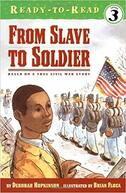Young Johnny loves his mule, Nell, and his Uncle Silas but hates being a slave. When presented with an opportunity to join the passing Union army, Johnny leaves the plantation and joins up. Though he likes being free, and is treated well by his fellow soldiers, Johnny misses Nell and Uncle Silas. His sadness is eventually lessened when he is asked to help a soldier take care of the mule team used to drive a supply wagon. Johnny is given an opportunity to show his new comrades how competent he is and, in the process, his bravery earns him a Union uniform.
The story is based on the memoirs of John McCline who ran away from his Tennessee plantation in 1862 to join up with the 13th Michigan Volunteer Infantry and who became a teamster for the regiment. McCline’s memoirs were published in 1998. This is a great, age appropriate introduction to a topic of African American self-liberation. There were approximately 179,000 former slaves and freedmen in the United States Colored Troops (USCT) and their role in fighting for their emancipation is often times overlooked in the greater discussion of Presidential and Abolitionist influence in the Emancipation Proclamation and the 13th Amendment. Children can begin to understand the iniquity of slavery through two age-appropriate concepts: sadness at separation and the lack of appreciation he receives for his hard work. Parents will recognize strong will and understand the need of children to be given an opportunity to prove themselves. Hopkinson focuses on Johnny’s sadness at the separation from those he loves most in the world—Nell and Uncle Silas. Johnny’s mother is “gone” and there is no indication why. She may have been sold, or she may have died or run away (though Johnny’s initial reluctance to do so himself probably means it wasn’t the latter). The separation of families was one of the primary themes of abolitionist literature, including Uncle Tom’s Cabin, and is a concept that children can understand, probably better than concepts of freedom and owning the fruits of your own labor. The theme also allows families to discuss why Johnny’s freedom doesn’t alleviate his sadness, and why sometimes in life, people can feel conflicting emotions. Children may also be able to relate to needing to hear praise for a job well-done, something that Johnny doesn’t get on the plantation but does receive from his fellow soldiers after he delivers supplies. As a parent with an elementary school student, Johnny’s insistence that he can do it (drive the wagon) on his own, resonates with me and is a nice reminder that while I parent, it is important to allow children the opportunity to prove they can, in fact, do important things on their own. The narrative is helped along by excellent, but subtle, illustrations by Brian Floca. Though the text is very gentle on the institution of slavery, the illustration accompanying Johnny’s tale of being beaten for a runaway cow is powerful in its understatement. The overseer beating a figure is so small and inconspicuous, it implies this happens regularly and is not an extraordinary event that requires attention. Hopkinson and Floca’s work is a great way to address important topics of slavery and freedom in an age-appropriate and relatable way.
0 Comments
Leave a Reply. |
AuthorToni is a wife, mom and history buff who loves bringing the Civil War to life for family members of all ages. Archives
July 2018
Categories
All
|

 RSS Feed
RSS Feed